Advertisement
Next Generation RNA Technology Could Unlock Treatments For Chronic Conditions
Resume
Even before scientists used modified RNA to create the Moderna and Pfizer-BioNTech COVID-19 vaccines, they dreamed of using the engineered genetic code to revolutionize medical treatments for many other diseases. There’s just one major problem: The body destroys the strands of RNA soon after they are injected.
That's fine for use in vaccines that aim to elicit an immune response, but it's impractical for chronic diseases such as diabetes or hemophilia, which require proteins to be supplied to the body for the long term.
“I would have to administer RNA very frequently for you to have a level of that protein you need consistently in perpetuity,” said Dr. Diego Miralles, the CEO of a new Cambridge biotech company, Laronde, where scientists are working on this problem.
Currently, RNA remains unusable for chronic treatments because patients would have to return to clinics repeatedly for new injections. But Miralles and others at Laronde think they’re closing in on a technique that would harness the power of RNA for weeks or months at a time. They call the new technology "endless" RNA or "eRNA."
“RNA is normally a very unstable molecule. It’s a molecule that, once created, gets eliminated quite quickly by the body,” said Avak Kahvejian, one of the founders of Laronde. “The endless RNA that we’ve created doesn’t suffer from those drawbacks and is very, very stable.”
RNA is a chain of genetic letters that can contain the instructions to make a protein. Most of the time, it’s shaped like a string, with a chemical marker at the start and a chemical marker at the end. These chemicals tell the cell where to begin reading the genetic code and where to stop. They also signal enzymes, which latch onto these chemical ends and destroy the entire molecule.
“[RNA] is a molecule that, once created, gets eliminated quite quickly by the body. The endless RNA that we’ve created doesn’t suffer from those drawbacks and is very, very stable.”
Avak Kahvejian, of Laronde
In graduate school, Kahvejian studied RNA molecules that are circles, not loose strings. Because circles never end, enzymes can’t latch on and chew them up. That gave him an idea: An RNA drug treatment in the shape of a circle would be able to stick around inside the cell for weeks or months. That would solve the stability problem, Kahvejian realized, but it created a new dilemma. Without ends, the cell doesn’t know where to start reading the RNA code.
“It’s like having a bead necklace. If all the beads on the necklace look the same, the cell doesn’t see it as something to read,” he said. “We had to coax the machines in the cell that make protein to somewhere inside the [RNA] circle so that it can start."
The team took inspiration from how viruses solve this problem by placing a genetic message into the RNA circle to tell the cell where to start reading. It functions like the cross on a rosary necklace, which marks where to begin praying.
“[The cell] then knows where to latch on and start reading through the necklace,” Kahvejian said.
Since the technology uses RNA that doesn’t have ends and lasts a long time, Kahvejian, of course, called it “endless RNA.”
He tested the idea in mice using the RNA code for a protein called luciferase, which emits light. He injected one group of mice with endless RNA and the other with typical, string-shaped RNA.
“Every few days we would draw blood and assess whether we had luciferase in the bloodstream. In the beginning, we saw it creep up [in all the mice]. We were very hopeful and excited, but then something really stark started to happen,” he said.
The mice injected with typical RNA stopped making luciferase, but the mice with endless RNA continued pumping out the protein. Each day Kahvejian and his team went to draw blood, they approached the machine that would detect luciferase’s fluorescence with a mix of hope and fear.
“We tried not to get our hopes up because we know science is fraught with failures. We know animals are unpredictable, and biology is hard,” Kahvejian said.
But two days passed, then three, then seven, and the mice kept producing luciferase.
"We’d be like, ‘Wow, OK. It worked. It’s probably not going to keep working',” Kahvejian remembered.
Yet, according to Kahvejian, the mice that got eRNA continued to make the protein for at least 20 days after the initial dose. He was ecstatic with the result. To Kahvejian, this was a sign they had succeeded in making a stable RNA compound that could produce proteins and maybe, one day, become the basis for new RNA medicines.
"All we know is that they have a very elegant idea. It may take a while before it becomes something effective."
Dr. Judy Lieberman
Kahvejian and Miralles haven’t published any of their data yet, so the findings can’t be verified by independent scientists. Dr. Judy Lieberman, an RNA biologist and pediatrician at Harvard Medical School, says without seeing the data, it’s impossible to know how well the nascent technology really works. Still, she says, it’s a brilliant idea.
“I wish I’d thought of this idea. It’s so obvious once you think of it and so neat,” Lieberman said.
It’s also getting funding from the same venture capital firm that launched the vaccine-maker Moderna, and Lieberman says she considers some of Laronde’s scientific advisors to be among the finest RNA biologists in the world. Even so, there’s a long road to success for the young company, and there are a lot of potential questions still unanswered.
“It’s hard to know if you’re going to get enough [protein]. Does it compare to the levels of protein you might need for a therapy? How long will it really last and will there be some sort of unforeseen side effects?” Lieberman wondered. “All we know is that they have a very elegant idea. It may take a while before it becomes something effective. It’s hard to speculate.”
If Kahvejian and Miralles are right, eRNA could be the key to new medical treatments that last in the body for weeks or months at a time. This would unlock a new generation of RNA therapies that could treat a broad range conditions including endocrine diseases and chronic diseases. The potential, they say, would be “endless.”
